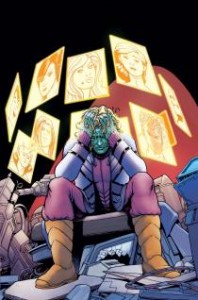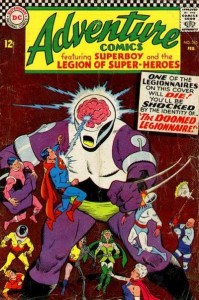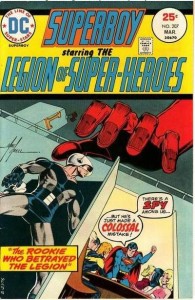 And so it ends… With issue #23 of The Legion of Super-Heroes, the ninth American series from DC Comics to bear that title, the Legion is no more. Does anyone care? Seriously, call out if you do, but I’m really wondering. Well, it’s clear that Paul Levitz cares. He’s been writing the title for the past few years, and wrote it from 1977 – 1989.
And so it ends… With issue #23 of The Legion of Super-Heroes, the ninth American series from DC Comics to bear that title, the Legion is no more. Does anyone care? Seriously, call out if you do, but I’m really wondering. Well, it’s clear that Paul Levitz cares. He’s been writing the title for the past few years, and wrote it from 1977 – 1989.
Come to think of it, it’s a toss-up as to whether or not I care. I waited several days to read the damned thing, and I believe I let the penultimate issues pile up into a stack of about six before I read them, all in one sitting. (I skimmed.) Was a time I would have read the new issue the day it came out, probably in the car on the way home. (I should point out I refer to a time when I did not drive. My mother drove, whilst I perched in the shotgun seat with a lime Slurpee. I learned early not to drink and drive, and certainly not to read comics and drive.) Nor did I skim in those days. Indeed, I told everyone around me to shut up, because I was reading. Or I hid in my room where the TV somehow never distracted me, because the comics were so good.
So maybe I don’t even care. I wait months to read the issues, and I skim. Sometimes, while I skim, I mutter things like, “Jesus, does this ever end? Is anything happening in this comic? Did I really spend three bucks (was a day when my weekly allowance was two bucks) on this?”
To be fair, I used to read all my comics the day I bought them. Now I have about a thousand boxed and unread. And I don’t know that the comics were that good, as much as it was that I hadn’t yet been exposed to the full range of storytelling–yeah, bullshit. They were that good.
Still, do I care that this group of super-heroes over whom I skim and mutter has been summarily written out of existence at the whim of the editorial body which operates under the moniker “New 52?”
You bet I do. Because the Legion stands for something.
 I first encountered the Legion in a house ad for Adventure Comics # 353. It was in one of my brother’s war comics from the 1960s. The masthead said it featured “Superboy and the Legion of Super-Heroes.” I knew Superboy, of course. He had a cartoon that ran in the afternoons. I’d discovered it after learning of the existence of super-heroes by watching the Adam West Batman, and of course Super Friends. He was Superman as a teenager. But I didn’t know the other eight heroes on the cover who were battling a giant monster in purple who had a see-through skull which generated lightning bolts. It looked pretty cool, though.
I first encountered the Legion in a house ad for Adventure Comics # 353. It was in one of my brother’s war comics from the 1960s. The masthead said it featured “Superboy and the Legion of Super-Heroes.” I knew Superboy, of course. He had a cartoon that ran in the afternoons. I’d discovered it after learning of the existence of super-heroes by watching the Adam West Batman, and of course Super Friends. He was Superman as a teenager. But I didn’t know the other eight heroes on the cover who were battling a giant monster in purple who had a see-through skull which generated lightning bolts. It looked pretty cool, though.
So when I went to the 7-Eleven one grocery day and found a three-pack of comics–I believe it offered three titles for 50 cents (cover price was 25)–and one of them was Superboy starring the Legion of Super-Heroes #207, I decided to give it a try. I wasn’t sure who the other heroes were–maybe some stray Justice Leaguers who hadn’t made it onto Super Friends yet–but I’d try it. I learned that the Legion lived 1,000 years in the future. They had nothing to do with the Justice League. Superboy traveled through time to be part of their team. I was hooked with that first issue. I discovered there were over two-dozen Legionnaires, and that they’d been around since before I was born. They each had a different power, most came from different worlds. They were all teenagers. They lived without adult supervision. How cool was this?
 A few years into my love affair with this teen team from the far future, a young man (he was, I later learned, only half a dozen or so years older than me) named Paul Levitz took over the book, which was soon renamed Superboy and the Legion of Super-Heroes, and then just The Legion of Super-Heroes, when Superboy left the team. Levitz took the Legion to new heights. Characters got married, characters died, characters became leaders on their own worlds. In short, characters grew. The third series called The Legion of Super-Heroes (1984) was one of the first (if not the first) DC Comics to be printed on high-quality paper and sold only through comic book stores, not on newsstands. The Legion became legit under Levitz.
A few years into my love affair with this teen team from the far future, a young man (he was, I later learned, only half a dozen or so years older than me) named Paul Levitz took over the book, which was soon renamed Superboy and the Legion of Super-Heroes, and then just The Legion of Super-Heroes, when Superboy left the team. Levitz took the Legion to new heights. Characters got married, characters died, characters became leaders on their own worlds. In short, characters grew. The third series called The Legion of Super-Heroes (1984) was one of the first (if not the first) DC Comics to be printed on high-quality paper and sold only through comic book stores, not on newsstands. The Legion became legit under Levitz.
As the years went on, the characters seemed not to age well, especially after Levitz left. In fact, at one point, they suddenly aged five years. Then they adopted teenaged clones of themselves who spun off into their own Legion. Then they were rebooted, starting fresh with new origins and new members. Then they got lost in space, far from earth. (It wasn’t as cool for them as it was for the Robinsons.) Then they got rebooted again, as a group of re-enactors / youths in revolt.
Finally, someone at DC said, “You know, the original Legion as they were created back in 1958 wasn’t so bad. Why don’t we just bring those characters back?” And they did. And then DC’s publisher, Paul Levitz (remember him?) decided to step down, and he came back to write the book again. Once again he created new characters, a group of young trainees who were interesting to learn alongside the older, classic Legionnaires. Things were looking good. DC respected this historic team and its concept. Indeed, when they declared the coming of the “New 52” (a massive reboot of the line, in which just about every character got a new origin, had his history wiped clean and started over), they said that the reboot didn’t affect the Legion.
Well… maybe that was the theory. The book did change. Several members were catapulted back into the 21st Century. The trainees from before the reboot were suddenly full members because the Legion was at reduced capacity. And, dammit, the book started to make a lot less sense. Maybe it’s just the modern storytelling that affected it. See, in the old days, a Legion scribe knew that, if you had 25 members on a team, you couldn’t show them all in one issue. No reader would be able to focus. New readers would be overwhelmed. So you used five or six per issue. And the stories were free-standing. Now there are no free-standing stories. Everything is a goddamned epic. And all the characters have to be in every issue because the plot is so freaking complex that you might forget who they are if they skip an issue. Me, I forgot what happened last issue every month, so…
Then someone (and I bet it wasn’t Paul Levitz) decided that the Legion was going to be eliminated so that DC could publish the adventures of a 31st Century Justice League. And how do you get a team of characters out of the way in modern comics? You Disassemble them. You break their spiritual backs. You shed all the character growth and character arcs you were carefully building up, because they don’t matter. You kill a few of them, you heap guilt on a few more, you make them dislike each other, you make a couple of them villains… Yeah. Like that.
And that’s what happened to the Legion. They got broke so badly that no writer would be tempted to try to fix them for, oh, a month or so. So badly that readers would say, “Yeah, we didn’t need those characters anyway, because they were broke so badly all along.” (They weren’t, but the clever thing about Disassembling a team is that it causes fanboys to believe that the new status quo stretches back in time forever amen.)
But I said they stood for something, didn’t I? And just what did they stand for?
Youth. Well obviously. They were all teenagers, right? They were believed to be, anyway, until the issue (sometime during the late 1970s) where it was revealed that, lifespans in the 30th Century being so long, many of them were well into their twenties and still going by code names that included “Kid,” “Boy,” “Girl,” “Lass,” and “Lad.” But beyond being chronologically young, the Legion were young in attitude. Kids, living without adults, taking on the universe and fighting all the evil it had to offer… and winning. Their youthful energy was infectious. (And not just because one of their members was named Infectious Lass.) And, unlike the grown-up heroes, who, let’s face it, could be awfully freaking smug, they knew they could make mistakes. They made them. They learned from them. (Okay, sometimes they also childishly turned on each other over them, but we’ll allow that ugly bit to drown in the infectious enthusiasm.) Remember the words of Bill Shatner? “Don’t be afraid to make an ass of yourself. I do it all the time!” (Second time I’ve quoted that this month, isn’t it? I don’t care. I love that quote.) There’s a guy who knows a thing or two about staying young.
Optimism. Goes hand in hand with youth, doesn’t it? Well, unless you’re a Goth. It means you still see the good in the world. You haven’t heard so many stories that most of them now bore you to tears. You haven’t met so many people that you start to think they’re disposable. And you’re not going around brooding (I’m looking at you, X-Men!) because the world hates you for being different. You believe things are pretty good just as they are, even when villains are out to get you, the human race seems to be turning on you, evil wizards are chasing you through time, and sun-eating monsters have to be stopped by your friend blowing himself up with an inertron bomb. You can face all of this because you have…
Hope. The Legion always had hope. They believed they could make a difference. They saw that they did make a difference. They knew that life goes on, and could deal with that. In fact, they planned for life to go on. They had a training academy. They had substitute heroes to cover for them when they weren’t available. They could see into the future (at least their readers could) and know that their team would carry on to the time when they were adults, would bring in new members, would continue.
Teamwork. There wasn’t one hero in these stories. There weren’t five or seven. They were a Legion. (Okay, 25 isn’t enough to make a Legion, really, but you get the idea.) They were many. They were a whole community of Super-Heroes.
Love. The Legionnaires were teens, as I keep saying. And, like all teens, they were interested in dating. The boys noticed the girls and the girls noticed the boys. Later, the girls noticed the girls. Still later, the boys noticed the boys. They paired off. They loved. The Justice League has the occasional kiss, the Teen Titans have been known to leave condoms on the floor for all to see, the Fantastic Four is led by a married couple; but the Legion was up to its ears in lovers.
Diversity. Okay, it’s an embarrassing fact that it wasn’t until the twenty years into their run that there was a black Legionnaire and a Native American Legionnaire. (Jim Shooter, Legion writer from the sixties, seventies and even the 21st Century, wanted his character, Ferro Lad, to be black under his full-face mask. He also wanted Element Lad to be revealed as gay. Neither came to be.) Still, the Legion included, not one token Super-Heroine, but eight or ten. More, if you counted Triplicate Girl as three. In an age when Wonder Woman had to resign the Justice League to Black Canary could join, that’s pretty good. And the Legionnaires were all from different worlds, as mentioned. While they didn’t have brown or red skins for a while, they did have green, blue and orange. And they were always on the leading edge of diversity in the Super-Hero community.
 The Future. Yes, dammit, the future! You think the future looks bleak now? Think what it looked like when Otto Binder and Al Plastino created the Legion back in the Fifties. H-Bombs were expected to wipe us off the face of the earth at any moment, but, at the same time, we were trying to get to the moon. There was the Viet Nam War going on, and people were dying. There was racial and social unrest. Yes, now we have terrorism, and we still have racial and social unrest… but why the hell aren’t we trying to get to the moon again? Because we’ve stopped thinking about the future. The Legion and its fans were all about the future.
The Future. Yes, dammit, the future! You think the future looks bleak now? Think what it looked like when Otto Binder and Al Plastino created the Legion back in the Fifties. H-Bombs were expected to wipe us off the face of the earth at any moment, but, at the same time, we were trying to get to the moon. There was the Viet Nam War going on, and people were dying. There was racial and social unrest. Yes, now we have terrorism, and we still have racial and social unrest… but why the hell aren’t we trying to get to the moon again? Because we’ve stopped thinking about the future. The Legion and its fans were all about the future.
No Justice in their name, though they believed in justice. No America. They didn’t work for Presidents or Kings, even though they seemed to respect those they encountered. (And, as mentioned, some of them became Presidents, Kings and Queens.)
They stood for a lot. Some of these things other teams and characters also stand for, but the Legion captured imaginations and grew a fandom in a way I haven’t seen any other comic book title do.
And now they are no more.
Of course, it’s comics. They can come back, right? Even in this final issue, Paul Levitz has his characters reflecting that, somewhere, in some reality, the Legion lives forever.
But, I wonder… in this reality… have we outgrown a group of kids who made us think about youth, optimism, hope, teamwork, love, diversity, and the future?
Gee, I hope not.
BTW, these are my personal reflections about the Legion, and they don’t really matter to anyone but me. If you’re interested in the publishable opinions of Paul Levitz, there’s an interview here. I haven’t read it yet. I was more egotistically concerned with giving you my opinions. I’ll go read his now. They’re probably more interesting.

It’s so true about every comic being a continuing epic. It makes it very difficult for a more casual fan like myself to get back into reading comics. I don’t always know when a new book is starting, so by the time I learn about it and check out the story I end up being so far behind and discouraged that I lose any desire to hunt down the earlier issues to catch up. I miss the days of the stand alone stories.
Sharon: Marvel has been doing a great job of making comics accessible to casual readers with its Marvel Now initiative. They even have some books, Like Avenging Spider-Man and A+X, that are done-in-one stories without having to hang on for arcs to play out. While many of their other books do have multi-part storylines, they do a good job of recapping things so you’re up to speed when you start reading.
Pingback: Back in the Day I Liked – Superboy Starring the Legion of Super-Heroes #208 - Steven H. WilsonSteven H. Wilson